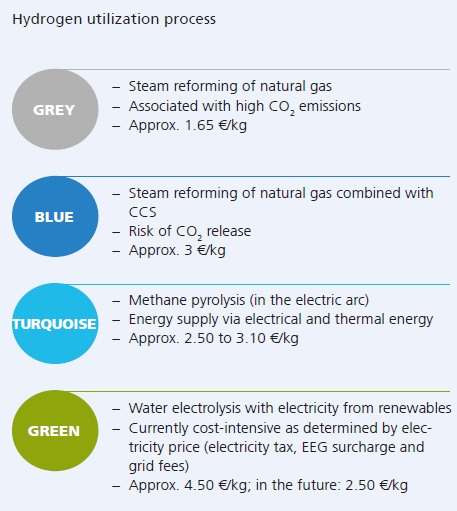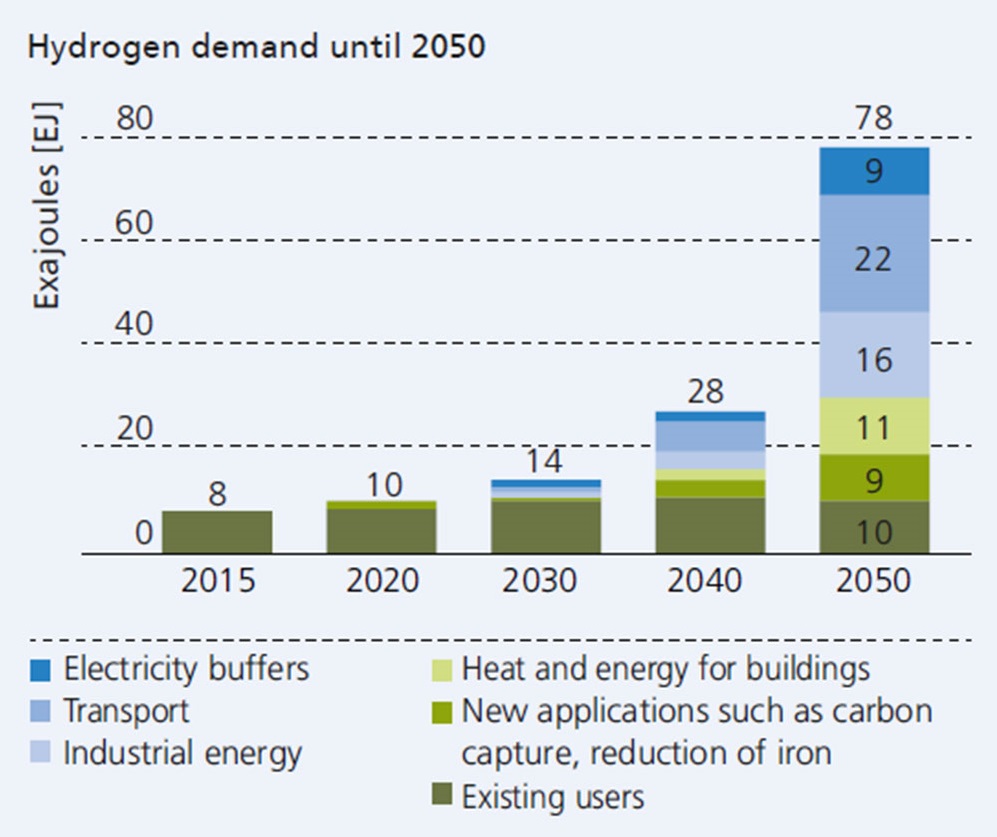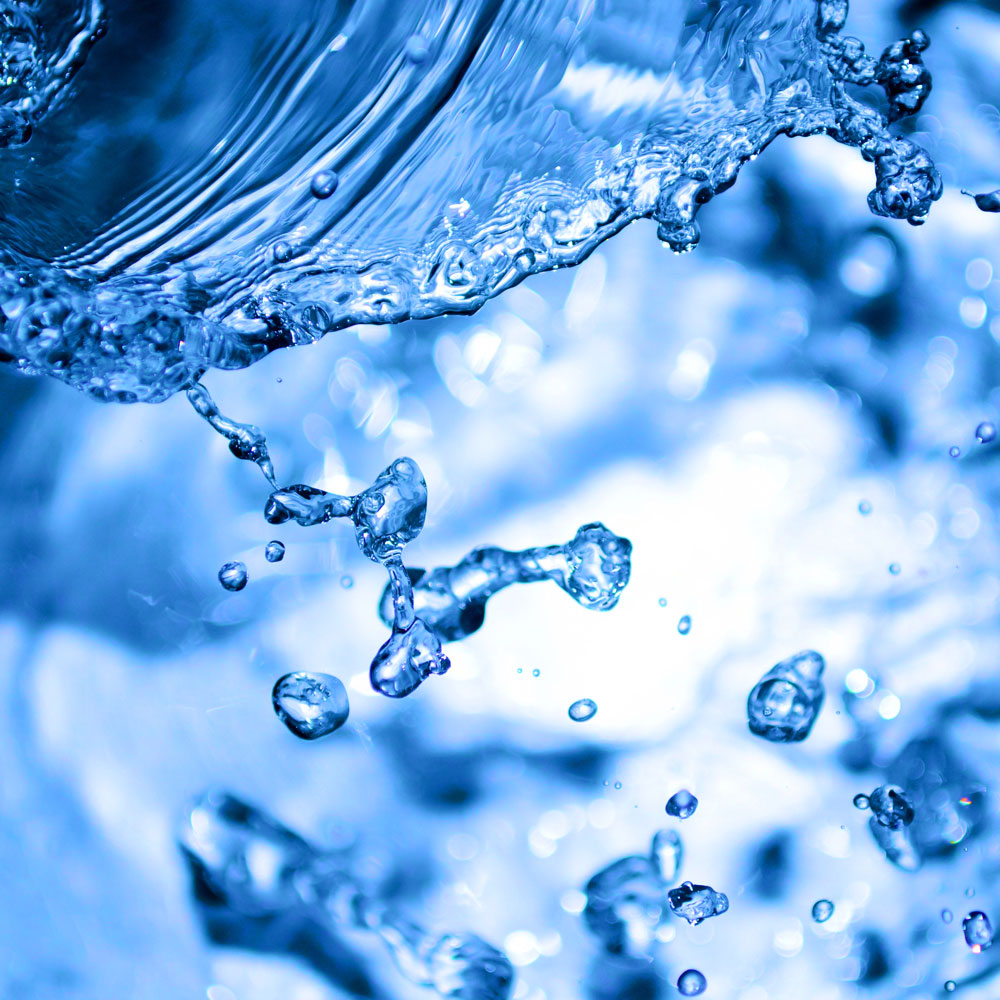
Hydrogen production

Hydrogen production technologies
Today, most hydrogen is produced by steam reforming of natural gas and called ‘grey hydrogen’. It is currently the production technology with the lowest associated costs. However, huge amounts of CO2 are released. If the CO2 is separated during reforming and stored in the earth (carbon capture and storage, CCS), one speaks of ‘blue hydrogen’. The challenge consists in ensuring safe long-term storage for the CO2. ‘Turquoise’ hydrogen is also produced from natural gas, with methane being split into carbon and hydrogen by applying heat or electricity. This process does not release CO2, but the emissions from upstream processes in the production chain are significant, as it is the case for all natural gas-based production processes. This also includes diffuse methane emissions occurring during natural gas extraction, which cause an even greater specific greenhouse gas effect than CO2. Also, it is still not clear how long-term storage of solidified carbon can be achieved. Alternatively, biogas can be used in all these processes instead of natural gas. Specifically, the use of biogenic residuals has advantages with regard to sustainability. However, the production costs would be much higher due to smaller plant sizes. Furthermore, the process chain and the associated emissions have to be taken into account as well, depending on the residual waste used.
In contrast, producing hydrogen via water electrolysis is largely emission-free, provided the electricity used comes from renewable energy sources. Hydrogen produced this way is called ‘green hydrogen’. In this regard Fraunhofer IKTS is working to develop various electrolysis technologies (see ‘Electrolysis’). High-temperature electrolysis is of particular interest in that context.
Biotechnological processes or concepts for producing solar hydrogen by means of photocatalysis are other options. Photocatalytic water splitting offers some clear cost advantages thanks to lower system complexity and the use of large-scale, proven technologies from the PV industry. A major disadvantage, however, is the currently lower overall efficiency. For this reason, Fraunhofer IKTS is working on new materials, advanced coating techniques and integrated overall systems to increase efficiency in the future.
Hydrogen market
Today, most of the hydrogen produced is needed in refineries and for ammonia synthesis, for the large-scale production of fuels and basic chemicals. Furthermore, large quantities of grey hydrogen are used for methanol synthesis or Fischer-Tropsch synthesis. The hydrogen is produced in large production plants using steam reforming. Almost the complete volume of the hydrogen produced this way is used directly on site, never reaching the market. One established route to produce hydrogen by using electricity is chlorine-alkaline electrolysis during which hydrogen is produced as a byproduct, some of which is brought to market. However, this route only accounts for 2 % of total hydrogen production.
For the sustainable development of a market for green hydrogen, production costs must be reduced. This can be achieved if the efficiency and long-term stability of the electrolysis processes used are increased further and if suitable framework conditions can be created. Furthermore, a demand-oriented hydrogen infrastructure needs to be established.
In addition, decentralized hydrogen production could prove to be a useful approach. Depending on the volumes of hydrogen required, producing locally on-site can be more affordable – for instance when operating a hydrogen filling station for buses and trucks. Decentralized production may also be helpful for lime and cement industries or in biogas plants producing value-added products. It is available faster and means less dependence on distribution networks.
Water as a resource for hydrogen production
If green hydrogen is to be commercially viable, sufficient quantities of pure water need to be made available for its production. Therefore, cost-efficient water treatment processes are gaining traction, in particular for decentralized applications. Depending on the location of the electrolyzer, this may involve the desalination of seawater as well as the treatment of industrial process waters.
To support these efforts, Fraunhofer IKTS combines the more classical ceramic membrane technology with electrochemical, sonochemical and photocatalytic processes and integrates these processes in modular plant concepts. This results in decentralized water treatment solutions and helps to increase local value creation. In particular with regard to the treatment of mining waters, IKTS has been committed to many years of development work and developed unique electrochemical processes and technical equipment, both to a high degree of maturity. These make it possible to treat mining water while at the same time separating hydrogen as a byproduct which can be utilized further (see ‘Membrane electrolysis‘). For coal mining regions undergoing profound structural changes, this could be a very promising approach.


